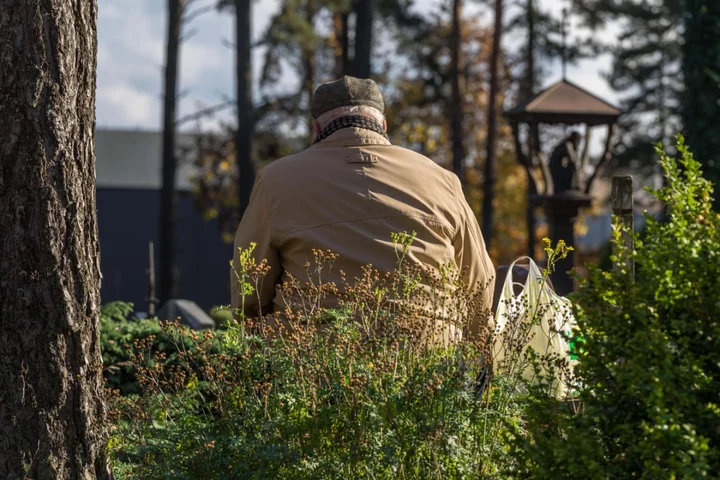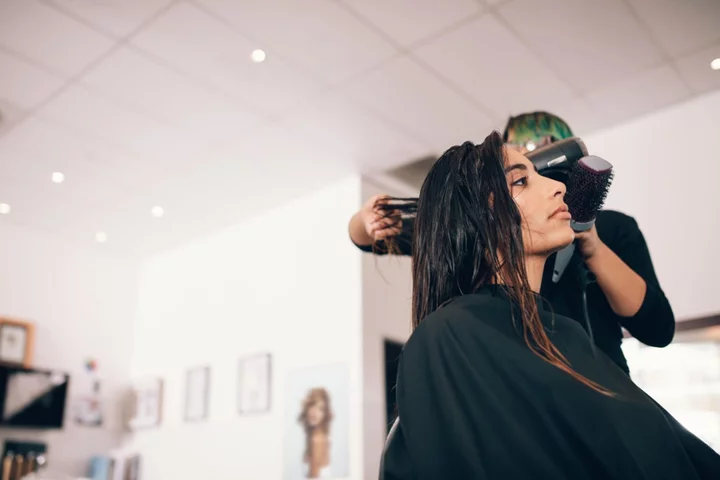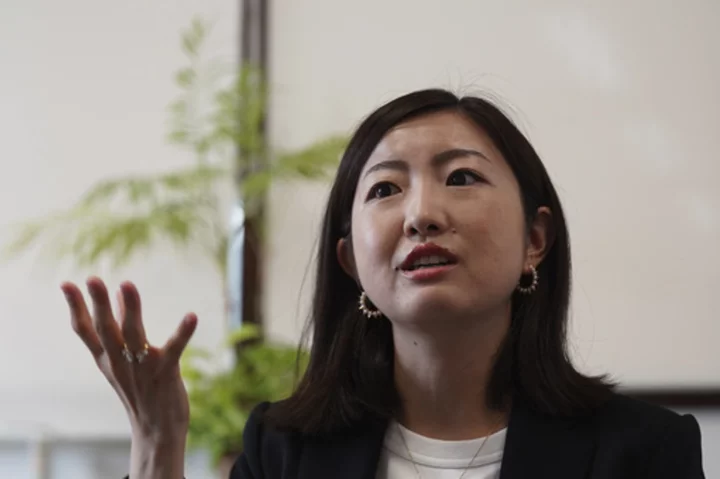
Nutritionist explains how women can eat to help balance hormones
Some healthy eating principles apply to just about everyone – drinking enough water and consuming plenty of fresh fruit and veg, for example. But when it comes to hormones, a lot of diet advice neglects to mention the vast difference between women’s and men’s health. “Women are very under-represented in research, mainly because we have a menstrual cycle,” says functional nutritionist and author Pauline Cox. “My passion and mission is to empower women with the information and knowledge that can radically change their immediate health and their long-term health.” Cox, 43, who started her career as a physiotherapist before becoming a nutritionist, now mainly works with groups of women online and has just released her second book, Hungry Woman: Eating for Good Health, Happiness and Hormones. “I felt there was a lot of information that could be shared with women to help them understand their hormones, and understand that we don’t have to get frustrated with ourselves and fight our female physiology.” At the heart of the issue is the balance (or lack thereof) between oestrogen and progesterone levels. “When our progesterone levels are low, our oestrogen can become dominant, and that’s when we start to see things like PMS, heavy periods, painful periods, flooding at the beginning of our periods,” says Cox, who lives in Somerset. “A lot o women accept that as part of their monthly cycle, but when we bring our progesterone levels back up, it helps to balance the effect of oestrogen.” Here, she explains five ways women can tailor their diets to keep their hormones in check… 1. Look after your liver “Oestrogen is a driving-growth hormone,” Cox explains, using the analogy of grass growing on a lawn to explain how the two hormones interact. “Progesterone is like the lawnmower. It comes along and it keeps the grass in check. When we lose progesterone, oestrogen gets out of control.” That’s why it’s important that our bodies are able to clear oestrogen efficiently through the liver, gut and bowels. “How much oestrogen we clear can be influenced by what we eat and how we live,” says Cox. “There’s a lot of cruciferous in the book – cauliflower, broccoli, these are really great vegetables to support liver detoxification.” 2. Add fermented foods To deliver beneficial bacteria to your gut, try including fermented foods like pickled vegetables, kefir, kombucha or natural yoghurt as part of your daily diet. “Our gut diversity declines as we age and microbiome diversity has been linked with longevity and good health,” says Cox, who suggests just a tablespoon of sauerkraut a day can make a difference. “These are easy wins…to maximise our longevity and optimise our gut-brain axis, which is incredibly important.” 3. Avoid ultra-processed foods There’s been a lot of talk recently about how detrimental ultra-processed foods are, and that includes the effect on hormone levels. “When we’re eating high sugar, processed foods, our inflammatory levels go up and our cortisol level goes up, which robs us of progesterone,” Cox says. Plus, filling up with these empty calories – as delicious as they often are – means we have less room for nutritious foods. “They can often be devoid of nutrients, so you’re not getting the nutrients you need for building hormones and supporting hormonal health like magnesium, zinc, B vitamins, and omega three fatty acids.” 4. Create an eating window It’s not just what you eat, it’s when. Cox recommends having an ‘eating window’ during the day that ends around 6pm, so that there’s a gap of a few hours before you go to bed. “When your blood sugars go up at night, your kidneys have to kick in to try and remove this excess blood sugar, which then means you’re up in the night urinating,” she says. “A lot of women associate this with drinking a lot before bed, but actually eating late at night can also be for that reason.” Choosing meals that are nutritious and satisfying is the next step. “Within that window, start becoming a bit more conscious of your carbs and upping your protein,” she continues. “So you’re feeling full, your body’s getting all the amino acids it needs, and you’re maybe not having so much of the grab-and-go food like the sandwiches, the pasta, the crisps.” 5. Monitor your magnesium “Most women are sub-clinically deficient in magnesium,” Cox explains, which can cause insomnia, and the risk increases with age. “As we get to about the age of 40, we absorb less magnesium than we would have in our 20s.” Diet also plays a role: “If we have high blood sugars and levels of inflammation when we’re stressed, we lose magnesium.” She recommends taking a magnesium glycinate or bisglycinate supplement before bed to increase your chance of getting a good night’s sleep. “The glycine part of that helps to reduce your core body temperature, which is what the body wants when it’s going to bed,” she says. “That compound also helps get you into what’s called REM sleep, which is the sleep where you’re consolidating memories and learning.” Hungry Woman by Pauline Cox is published by Ebury Press, priced £27. Photography by Luke Albert. Available Now. Read More From hairdressers to aloe vera: What will Diet Coke join as a ‘possible cancer risk’ Charity boss speaks out over ‘traumatic’ encounter with royal aide Ukraine war’s heaviest fight rages in east - follow live
2023-06-30 22:53

Flight Disruptions Linger Ahead of Busy Holiday
US airlines continued to grapple with flight disruptions heading into the busy weekend ahead of Independence Day, keeping
2023-06-30 21:27

‘World’s most-advanced’ humanoid robot has ability to draw perfect pictures on command
A robot dubbed the 'world's most-advanced humanoid' has left tech-lovers shocked for her ability to complete request-based tasks. The public are already familiar with Ameca, after she previously went viral for her ability to speak multiple languages. However, in the new video by Engineered Arts, Ameca is given a pen and told to drawer a 'cute-looking cat'. "Whether it's a cuddle when we're feeling down or a playful scratch behind the ears when we need a pick-me-up, they are always there for us", she says, as she gets to work. Within a minute, the robot has sketched a super-accurate looking cat drawing on the canvas. Read More Be loud, be proud: My life after leaving countries dangerous for the LGBT+ community Aspartame: What effects do carcinogens have on your body? Sprawling nature art installation takes over London’s ‘super sewer’ 50m below ground
2023-06-30 20:58

FIFA allows anti-discrimination captain's armbands at Women's World Cup after standoff in Qatar
The anti-discrimination “One Love” captain’s armband denied to teams at the men’s World Cup in Qatar will be worn at the Women’s World Cup next month in an amended version now approved by soccer authorities
2023-06-30 20:24

Chicago’s Nascar Weekend Offers Headaches, Little Economic Gain
Nascar is about to hit the road in Chicago for the first-ever street race in its marquee series.
2023-06-30 19:51

Every Barbie-inspired outfit Margot Robbie has worn so far
Margot Robbie has started the press tour for highly anticipated upcoming movie Barbie in suitable fashion. The film – slated for release on July 21, is directed by Greta Gerwig, and Robbie’s co-stars include Ryan Gosling, Issa Rae, Dua Lipa, Ncuti Gatwa and more. Robbie’s stylist, Andrew Mukamal, has posted the latest Barbie-inspired outfit she’s worn to promote the movie on Instagram. The Wolf Of Wall Street star dipped into the archives for this look, wearing a metallic pink mini skirt and pale pink cropped rollneck jumper from the Versace autumn/winter 1994 collection. Supermodels Cindy Crawford and Claudia Schiffer appeared in the original advertising campaign for this collection, and the pink look Robbie has chosen was worn by Christy Turlington. Her Barbie-inspired looks haven’t just been about all-pink outfits, however. On Thursday, the 32-year-old was promoting the movie on Sydney’s iconic Bondi Beach, and her outfit paid tribute to the first-ever Barbie doll, which was released in 1959. The first doll wore a black and white striped swimsuit, which Robbie mirrored with a monochromatic striped mini dress with a distinctly retro feel. Later that day, she changed into another Fifties-inspired mini dress – this time by Moschino, with a graphic strawberry print and worn with statement white sunglasses. Proving her dedication to the theme, Robbie hasn’t just been channelling Barbie on the red carpet and for photo calls. She was even seen walking through Sydney airport in an ensemble worthy of the famous doll: a pale pink tweed blazer and grey trousers from Chanel’s spring/summer 1996 collection, while wheeling vintage-inspired pink luggage. Her bags were from Steamline luggage: The Entrepreneur Pink Hatbox Small retails at £251, and The Entrepreneur Pink Carryon costs £468. For a Los Angeles photo call, Robbie again took direct inspiration from a Barbie doll. This time she wore a pink polka dot mini dress by Valentino with a yellow handbag, echoing the outfit worn by a 2015 doll from the Pink and Fabulous collection. Setting the tone for the whole press tour, Robbie kicked off her themed fashion looks earlier this week while posing next to Barbie’s car – which she matched in a custom pink two-piece by Bottega Veneta. With the film not out for a few weeks yet and plenty of premieres in the diary, chances are we’ll be seeing a lot more Barbie-inspired fashion from Robbie to come. Read More Charity boss speaks out over ‘traumatic’ encounter with royal aide Ukraine war’s heaviest fight rages in east - follow live Being lonely ‘may increase risk of heart disease in diabetes patients’ 7 ways to save money on your hair Sarcoma Awareness Month: What you need to know about these cancers
2023-06-30 17:16

Thousands of Passengers Stranded in Geneva Amid Airport Strike
A strike at Geneva airport disrupted travel for thousands of passengers on Friday, fueling fresh concern that protests
2023-06-30 16:49

The Most Romantic City in France Is Not Paris, According to This Chef
At Bloomberg Pursuits, we love to travel. And we always want to make sure we’re doing it right.
2023-06-30 16:18

Being lonely ‘may increase risk of heart disease in diabetes patients’
Being lonely may the increase risk of heart disease in diabetes patients, research suggests. Scientists have found loneliness to be a bigger risk factor for coronary heart disease – a condition where the blood vessels supplying the heart are narrowed or blocked – than diet, exercise, smoking and depression. The researchers said their findings, published in the European Heart Journal, highlight the importance of meaningful social relationships to stay healthy. Study author Professor Lu Qi, of Tulane University School of Public Health and Tropical Medicine in New Orleans, said: “The quality of social contact appears to be more important for heart health in people with diabetes than the number of engagements “We should not downplay the important of loneliness on physical and emotional health. “I would encourage patients with diabetes who feel lonely to join a group or class and try to make friends with people who have shared interests.” For the study, the researchers looked at data from the UK Biobank – an online database of medical and lifestyle records from more than half a million Britons – involving more than 18,000 adults aged between 37 to 73. These people had diabetes but no heart disease at the start of the decade-long study. The researchers used questionnaires to assess loneliness and other factors that may affect relationships such as body mass index (BMI), physical activity, diet, alcohol, smoking, and medications, blood pressure, cholesterol and control of blood sugar. The findings suggest that asking patients with diabetes about loneliness should become part of standard assessment, with referral of those affected to mental health services Prof Lu Qi Over the course of more than 10 years, more than 3,000 people developed heart disease, which included coronary heart disease or stroke. The researchers found those who scored the highest in loneliness had a 26% greater risk of heart disease, compared to people with lower scores. The team also found loneliness to be a bigger risk factor for heart disease than diet, exercise, smoking and depression – but showed a weaker influence when compared to kidney function, cholesterol and BMI. Professor Qi said: “Loneliness ranked higher as a predisposing factor for cardiovascular disease than several lifestyle habits. “We also found that for patients with diabetes, the consequence of physical risk factors (ie poorly controlled blood sugar, high blood pressure, high cholesterol, smoking and poor kidney function) was greater in those who were lonely compared to those who were not.” “The findings suggest that asking patients with diabetes about loneliness should become part of standard assessment, with referral of those affected to mental health services.” Read More Charity boss speaks out over ‘traumatic’ encounter with royal aide Ukraine war’s heaviest fight rages in east - follow live 7 ways to save money on your hair Sarcoma Awareness Month: What you need to know about these cancers Bjork’s controversial swan dress to go on display in new exhibition
2023-06-30 16:18

7 ways to save money on your hair
From salon visits to shampoo, looking after your hair can be an expensive business. And unlike things like manicures or waxing – which you can do at home if you so wish – hair-cutting is best left to the pros. Yet there are ways to save money at the hairdressers and at home. Here, experts offer their advice for affordable hair care… 1. Low-maintenance cuts Some hairstyles require more regular trims than others. An Anna Wintour-style bob, for example, is the pinnacle of high-maintenance hair. “The best way to make your pennies stretch in between appointments is to opt for a low-maintenance haircut,” says Tyler Moore, expert stylist at Live True London. “These longer-lasting haircuts are usually ones that grow out gracefully and are on the longer side.” For long hair, he recommends a layered style: “Ask for some long, movement-creating layers to add some definition and shape to your cut. “These will grow out relatively well and will only need maintaining when you want to tidy your cut up.” Avoid blunt fringes that will need trimming a lot, but parted ‘curtain bangs’ won’t require as much upkeep. “If you prefer to keep things short, ask your hairdresser for a sleek, one-length chop,” says Moore. “If you don’t mind rocking several different lengths over a period of time, opt for a layer-free chop. The shorter you go, the more mileage you’ll get out of this.” 2. DIY dye For dark hair in particular, box dye is very affordable, especially compared to an appointment with a salon colourist. But what if you’ve never gone DIY before? “When in doubt, choose a shade that is on the lighter side – you can always go a shade darker the next time,” says Carin Freidag, global senior hair education manager at Clairol. To ensure rich all-over colour she advises: “Make sure you fully saturate your hair with the colourant mixture. If you have long or very thick hair, get two boxes so you have enough.” Start by doing an allergy patch test 48 hours before application following the instructions in the box. “Do the strand test at the same time since you will have some of the mixture left over,” Freidag says. “Simply apply the mixture to a small portion of hair and set the timer for 25 minutes. Wipe off with a wet paper towel, dry it and see how you like it.” If you’re happy, carry on: “Part and clip your hair into four sections so it’s easier to manage. If you are covering grey, start in the section where you have the most grey.” 3. Keep your blonde bright “If you’re blonde, keeping your colour looking salon fresh means booking a salon appointment for a toner, especially after the summer months,” says celebrity hair stylist and Olaplex expert Tom Smith. “However you can extend the life of your blonde colour with Olaplex No. 4P Blonde Enhancer Toning Shampoo which neutralises unwanted yellow tones, leaving your hair brass-free blonde for longer.” Kris Barnes, celebrity colourist and Provoke ambassador agrees that purple shampoo is a must for blondes. “The Provoke Touch of Silver range is brilliant for keeping hair vibrant and it’s such a steal,” he says. “My clients can maintain their colour affordably at home and come to me slightly less often than before.” Olaplex No.4P Blonde Enhancer Toning Shampoo, £28 Provoke Touch Of Silver Brightening Shampoo, £2.99, Boots 4. Long-lasting colour As with cuts, some types of hair colour require more maintenance than others, such as all-over shades. “I would say switch up the colour a bit and go for a more lived-in colour,” says Barnes. “A blonde balayage or some depth towards the root will mean you can go a bit longer between colour visits, whereas full highlights will mean roots show quickly and will need re-doing.” Moore adds: “Steer clear of bright fashion colours, cool-toned blondes, and coppers – these require a lot of upkeep.” 5. Cover your roots Root cover-up spray is a brilliant way to extend the time between your colour appointments, and there’s a huge range of shades to choose from. “Simply shake and spray right where you need it and voila, done!” says Freidag. “It’s removed with shampoo so gives you the flexibility to go to the gym or out on a rainy day without fear of it running.” Clairol Root Touch Up 2 In 1 Spray Light Brown, £8.99, Boots 6. Use dry shampoo Refreshing your hair more often with a cheap-as-chips dry shampoo saves money on liquid shampoo and conditioner, as well as your water and electricity bills. “The way to get the most out of your dry shampoo is to give the can a big shake to awaken the formula and then ensure you are spraying at least 30cm away from the roots,” says hair stylist and Batiste brand ambassador Samantha Cusick. “Don’t spray close to your head that’s how you’ll get powdery residue. Don’t forget to massage in and then brush out to be most effective.” Batiste Dry Shampoo Tropical, £3.59, Superdrug 7. Make your own mask “Create your own deep conditioning masks using ingredients found in your home, like olive oil, peppermint and honey,” says Oyinkansola Adebayo, founder of Niyo Hair and Beauty. Other foods recommended by beauty buffs include coconut oil, avocado, bananas and egg yolk. “These natural products nourish, enhance your curls and moisturise your hair without the hefty price tag of store-bought treatments which may have ingredients harmful for your hair.” Read More Charity boss speaks out over ‘traumatic’ encounter with royal aide Ukraine war’s heaviest fight rages in east - follow live Sarcoma Awareness Month: What you need to know about these cancers Bjork’s controversial swan dress to go on display in new exhibition Chrissy Teigen welcomes fourth child – how does surrogacy actually work?
2023-06-30 15:27

Sarcoma Awareness Month: What you need to know about these cancers
Although most people have heard of sarcomas, research suggests the majority don’t really know what they are. A study by Sarcoma UK found 75% of people didn’t know what a sarcoma was – but there’s no better time than July’s Sarcoma Awareness Month to learn. Sarcomas are rare cancers that can either form in the bones or soft tissues that connect, support and surround other body structures and organs, explains Sarcoma UK. “If you’ve never heard of sarcoma before, you’re not alone,” says Dr Sorrel Bickley, director of research, policy and support at Sarcoma UK. “Sarcoma can affect any part of the body, on the inside or outside, including the muscle, bone, tendons, blood vessels and fatty tissues.” She says around 15 people are diagnosed with sarcoma cancer every day in the UK, and stresses: “It can affect anyone, at any age, and it’s vital that healthcare professionals can recognise its signs and symptoms.” During Sarcoma Awareness Month the charity is running a campaign called Does Size Matter?, in a bid to draw attention to the fact that a lump getting bigger is a key sign of sarcoma. “Most lumps and pains won’t be sarcomas, but it’s important to keep an eye on symptoms and to seek medical help if you’re worried,” stresses Bickley, who explains that many patients tell the charity it’s taken a long time for them to get a correct diagnosis. She adds: “Many people don’t consider their symptoms might be serious. Delays cost lives, and people have a better chance of surviving sarcoma if their cancer is diagnosed early. ” There are around 100 different subtypes of sarcoma, grouped into soft tissue sarcomas and bone sarcomas, and Bickley explains: “Soft tissue sarcomas may not have obvious symptoms in the early stages when the tumour is very small. The symptoms can become more obvious as the sarcoma grows, but this can depend on where in the body it’s found. ” She says there are several main sarcoma symptoms to be aware of… A lump that grows or changes Bickley says sarcoma is a “complicated cancer”, but the most common symptom is a lump, which could be anywhere on the body – including the arm or leg. “Most lumps aren’t harmful and a lump that isn’t getting bigger, isn’t causing any pain, or that has been there for a long time isn’t likely to be anything to worry about,” she says. “But if it’s growing quicky or measures more than five centimetres – about the size of a golf ball – then you should get it checked by your GP.” Swelling or pain in or around a bone Sarcoma cancer can also start in a bone – the most common symptoms are unexplained pain or tenderness around a bone, which may come and go and may be worse at night, explains Bickley. “If the pain is getting worse and doesn’t go away with rest or at night, you should go and see your GP to get it checked,” she advises. Stomach pain, feeling sick and loss of appetite Some forms of sarcoma – known as a gastrointestinal stromal tumours, or GISTs – can start in the gastrointestinal tract. “With this type of sarcoma, people most often experience symptoms like fatigue, anaemia, weight loss, feeling sick or discomfort around their stomach,” Bickley says. Blood in poo or vomit Noticing blood in your poo or vomit can also be a sign of a gastrointestinal stromal tumour, says Bickley, who adds: “There are lots of causes for blood in poo or vomit, but it needs to be checked by a medical professional.” For more information or advice about sarcoma, call the Sarcoma UK support line on 0808 801 0401, email supportline@sarcoma.org.uk, or text 07860 058830 to contact a specialist adviser. Read More Charity boss speaks out over ‘traumatic’ encounter with royal aide Ukraine war’s heaviest fight rages in east - follow live Bjork’s controversial swan dress to go on display in new exhibition Chrissy Teigen welcomes fourth child – how does surrogacy actually work? 11 ways to work the colour clash trend at home
2023-06-30 14:47

In workaholic Japan, 'job leaving agents' help people escape the awkwardness of quitting
In Japan, a nation reputed for loyalty to companies and lifetime employment, people who job-hop are often viewed as quitters
2023-06-30 12:18
